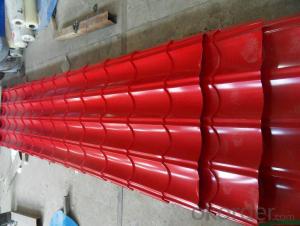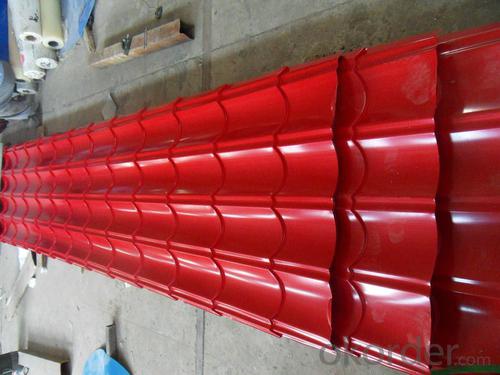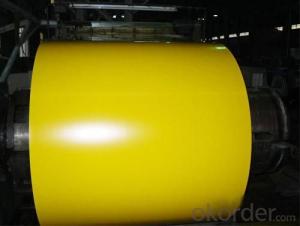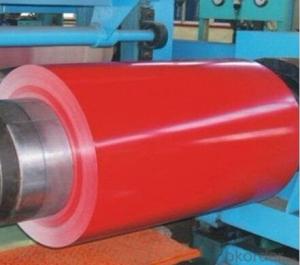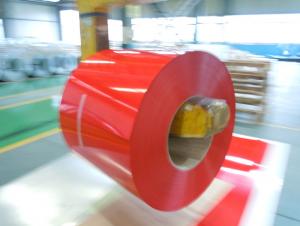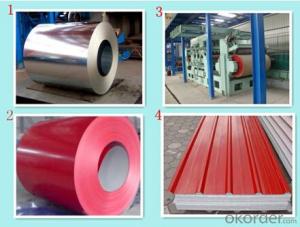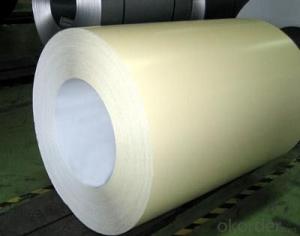PRE-PAINTED GALVANIZED STEEL ROOF HIGH QUALITY
- Loading Port:
- Shanghai
- Payment Terms:
- TT OR LC
- Min Order Qty:
- 50 m.t.
- Supply Capability:
- 10000 m.t./month
OKorder Service Pledge
OKorder Financial Service
You Might Also Like
· Standard: AISI, ASTM, BS, DIN, GB, JIS
· Grade: SGCC SGCH SGCD DX51D
· Thickness: 0.13-3.0mm
· Place of Origin: Tianjin, China (Mainland)
· Model Number: AISI, ASTM, BS, DIN, GB, JIS
· Type: Steel Plate
· Technique: Cold Rolled
· Surface Treatment: Galvanized
· Application: Container Plate
· Special Use: High-strength Steel Plate
· Width: 30-1500mm
· Length: any length
· color: RAL color
· place of origin: Tianjin, China
- Q: How are steel coils coated for specific applications?
- Steel coils are coated for specific applications through a process called coil coating. This involves applying a protective layer of paint, polymer, or other coatings onto the steel coils using methods like roll coating or spray coating. The coating is carefully selected based on the desired properties such as corrosion resistance, durability, or aesthetic appeal required for the specific application.
- Q: How do steel coils contribute to the manufacturing of appliances?
- Steel coils are used in the manufacturing of appliances as they serve as a primary raw material for various components such as frames, panels, and structures. These coils are processed and shaped into different forms to meet the specific requirements of different appliances. Additionally, steel coils provide durability, strength, and corrosion resistance to appliances, ensuring their long lifespan and high-quality performance.
- Q: Alright, First off i have an old plywood military box with galvanised steel corners, hinges etc (any part that must be strong) and its rusting! Some of the pieces have discoloration (like an oil stain on them) and other parts are full of this metallic dust. 1) Should i remove this box from my room?2) Is there any way or should i remove the powder on the part?3) Does this pose a serious health hazard?4) What are the oil stains?
- Wipe the powder of and the rest should be safe, unless you stub your toe on the rusty metal.
- Q: How are steel coils processed for different levels of hardness?
- Different levels of hardness can be attained in steel coils using a variety of methods. One common approach is heat treatment, in which the coils are heated to a specific temperature and then rapidly cooled to modify their microstructure and achieve the desired hardness. The heat treatment process can encompass quenching, tempering, or annealing, depending on the desired hardness level. Quenching involves quick cooling of the coils in a liquid medium like water or oil to achieve a high hardness level. On the other hand, tempering requires reheating the coils to a lower temperature and gradually cooling them to attain a desired balance between hardness and toughness. Annealing, on the other hand, involves heating the coils to a specific temperature followed by slow cooling to release internal stresses and obtain a softer and more malleable material. Additionally, mechanical processes like cold rolling or cold working can be employed to enhance the hardness of steel coils. These processes involve applying compressive forces to the coils, causing the material to deform and resulting in increased hardness. Overall, achieving different hardness levels in steel coils requires meticulous control of temperature, cooling rate, and mechanical forces to obtain the desired properties for specific applications.
- Q: What are the different types of steel coil cuts?
- There are several different types of steel coil cuts, including hot-rolled, cold-rolled, galvanized, and stainless steel coil cuts.
- Q: which is the most tough and durable steel type ??
- C'mon. Really? That's your question? How about some actual details like the application, is it going to be formed into a shape, do you need to weld it, what type of environment like corrosion and temperature is it going to be subject to? There are roughly 2,000 grades of steel and a couple hundred grades of stainless steel. Steels can be soft or they can be exceptionally hard. We need more info please.
- Q: How are steel coils used in the marine industry?
- Steel coils are commonly used in the marine industry for various applications such as shipbuilding, offshore structures, and maritime equipment. These coils are used to manufacture components like hulls, decks, bulkheads, and other structural parts that require high strength and durability. Additionally, steel coils are also used in the production of marine machinery, pipelines, and storage tanks, ensuring the reliability and performance of vessels in harsh marine environments.
- Q: How are steel coils used in the manufacturing of suspension systems?
- Steel coils are commonly used in the manufacturing of suspension systems as they provide the necessary support and flexibility to absorb shocks and vibrations. These coils are typically shaped into springs and placed in the suspension system of vehicles, helping to maintain stability, improve handling, and ensure a smooth ride by absorbing the impact from uneven surfaces on the road.
- Q: Corten steel tends to overheat in hot environments? (for example copper heats up under the sun)
- Weathering steel, best-known under the trademark COR-TEN steel and sometimes written without the hyphen as Corten steel, is a group of steel alloys which were developed to obviate the need for painting, and form a stable rust-like appearance if exposed to the weather for several years. Overheating ? It's not possible for a metal to get hotter than it's environment unless there is a source of radiation. The sun shining on a metal will heat up a bit, as will any material, but the amount is small and depends on the surface reflectivity. Define what you mean by overheating. .
- Q: I want to get one of these knives but I am having trouble deciding which is the best overall knife??ThanksSOG Trident tigerSOG Vulcan TantoSOG Bi-Polar (Serrated)Cold Steel ScimitarCold Steel Recon 1
- May be you'll find something amongst those. Again, CQC-7 is a tanto blade and you wont find much use for it for every day use. You can, if you try, but why bother. Also, they today use 154CM steel, pretty good, used to be the top stainless cutlery steel, but rather old now. Hardened to 59-61 HRC. It's not that hard in the end, but will hold considerably better edge than AUS8 steel knives. One thing about CQC-7 it's using liner lock, which is not as strong or convenient as benchmade Axis Lock. Another thing to consider about CQC-7 is it's chisel grind, or single bevel. One side of the blade is flat, the edge is ground only on the opposite side. While this is easier to sharpen, one side vs. 2 sides on conventional blades, it has disadvantages in terms of normal cutting. Takes time to get used to it and you can't use it in certain grips to cut in different direction etc...
Send your message to us
PRE-PAINTED GALVANIZED STEEL ROOF HIGH QUALITY
- Loading Port:
- Shanghai
- Payment Terms:
- TT OR LC
- Min Order Qty:
- 50 m.t.
- Supply Capability:
- 10000 m.t./month
OKorder Service Pledge
OKorder Financial Service
Similar products
Hot products
Hot Searches
Related keywords
